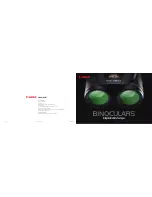
lamp-holder is fastened on the clip attached to the drawtube of the right eyepiece of the binoculars, the
other lamp-holder is fixed on the tell-tail pipe. If the lamp-holder is positioned correctly at the seat the
catch enters the respective slot of the seat of the lamp-holder under the action of a spring and prevents it
from coming off. The illumination brightness of the reticles is adjusted by a diaphragm with the help of
screw 10 which moves along the guide slot of the lamp-holder casing.
Device PNB-3-1 has no system of illumination and tell-tale pipe.
The portable lamp is used for illumination of the outer scales. With the help of a holder the portable
lamp is suspended on the tripod cramp. On pressing button 2 the lamp lights.
In the process of operation the device is mounted on the tripod. The basic parts of the tripod are head
5 (Figure 4), a pin and three adjustable legs 10.
To protect the tripod against damage in transportation one should put cap 7 on the tripod pin. There are
cramps on two legs of the tripod for suspension of the housing which contains accumulators 9 and of the
box which contains light filters 8. Prior to transportation of the device one should remove the accumulator
and box and put them in the packing cases.
The tripod is carried with the aid of a shoulder belt 3. At intervals in operation,when it rains, snows, on
the wind and in the dust-storm the device is to be covered with a cover which is tightened under the
horizontal limb and a knot is made of a cord.
6 ORDER OF OPERATION
6.1 Setting of Device in Working Position
For setting the device in the working position it is necessary to mount rigidly the tripod on the ground, secure
the tripod legs by screwing in screws 11 (Figure 4) and pedals up to the stop. Remove protective cap 7 from the
tripod pin. Suspend storage battery 9 and box 8 with light filters on the tripod legs.
Remove the device from the packing case and with the released clamping screw 3 (Figure 3) of the
bushing of the limb base, mount it on the tripod so that a key screwed in the tripod pin enters one of the
slots of the limb base, after doing so secure the clamping screw.
Secure the tell-tale pipe on device PNB-3.
Clean the outer optical pieces of the device.
Mount the headrest on the device.
Fix the lamp-holders at the seats of the eyepieces of the binoculars and tell-tale pipe. In operation
at night connect the plug coupling to accumulator 17 (Figure 1).
Level the device by a spherical level. Use the tripod legs for levelling. If the device is levelled properly
the level bubble must not deviate for more than one division in rotation of the device in azimuth through
180°.
6.2 Preparation of Device for Operation
Remove the protective caps from the eyepieces and wipe the device and optical pieces with a tissue if
necessary.
Set the eyepieces for the image sharpness by an observer’s eyes. To perform this release the brakes
of the laying for elevation and direction by using handwheels 8 (Figure 1) and 11 (Figure 3) and aim the
device at any sharply-outlined object remoted at a distance of minimum 3 km.
Obtain a sharp image of the object to be observed in the eyepieces of both telescopes of the
binoculars in turn for each eye by rotating the eyepiece rings (in doing so close the eyes in turn or darken
the inlet ports of the device).
Memorize the settings on the diopter scales and use them later on for correct and quick setting of the
eyepieces for the image sharpness for your eyes.
Set the eyepieces to the distance equal to the observer’s interpupillary distance. To perform this obtain
visibility of the whole field of view without cutting off its edges by rotating handwheel 14 (Figure 1) and
observing through the device. The device field of view must be seen as one whole circle. Memorize the
value of the interpupillary distance on scale 15 (against index 16) and use it later on in operation with the
device. Check the setting of the headrest. The pupils of the observer’s eyes must be aligned with the exit
pupils of the device, and the device field of view must be observed without darkening or cutting of the
edges.
The device should be oriented every time after setting the device in the working position, For
orientation by a remote point release handwheels 8 (Figure 1) and 11 (Figure 3) of the device brakes
and aim the reticle centre of the device at the chosen remote point. Secure the device against rotation by
the horizon by screwing handwheel 11 in hard. Release handwheel 14 of the stopper of the limb of
traversing angles and set the chosen traversing angle by the limb scale by rotation of the limb with the




























